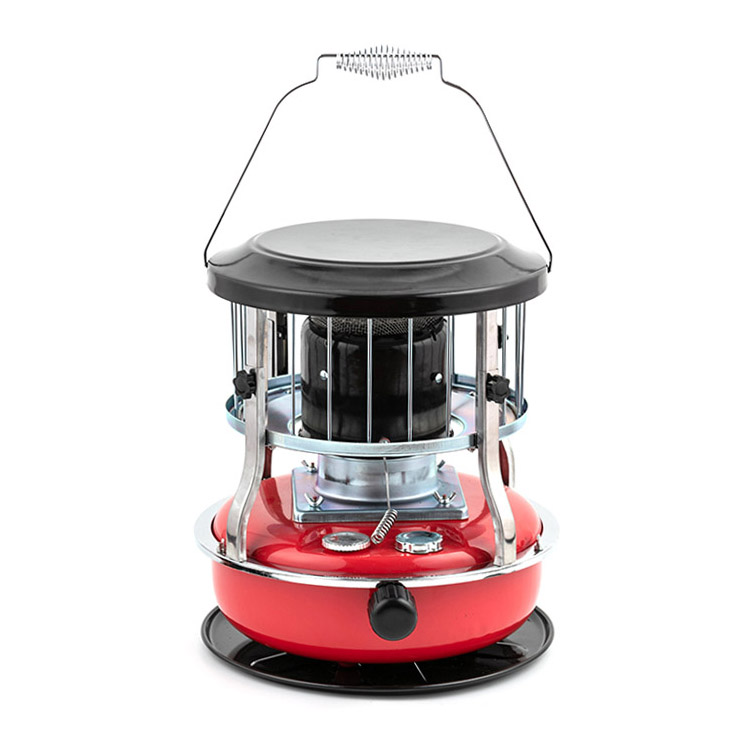Red Fuel Tank Kerosene Heater is an indoor heating device powered by kerosene fuel, with a visible red fuel tank that can be refilled for continued use. The heater is designed to release heat into the room by burning the kerosene, which is stored in its fuel tank. It is a popular and cost-effective solution for providing heat during cold weather conditions in areas without access to central heating systems.

What are the environmental impacts of using Red Fuel Tank Kerosene Heater?
One of the primary environmental impacts of using a Red Fuel Tank Kerosene Heater is the release of carbon monoxide and nitrogen dioxide into the air. These are harmful gases that can cause respiratory problems and pollute the air, especially when the heater is not properly maintained.
How can you minimize the environmental impacts of using Red Fuel Tank Kerosene Heater?
One way to minimize the environmental impact of using a Red Fuel Tank Kerosene Heater is to ensure proper ventilation. This can be done by opening a window or door to provide fresh air circulation in the room. It is also important to have the heater regularly checked and maintained to ensure clean burning and minimize the production of harmful gases.
Is Red Fuel Tank Kerosene Heater safe to use?
Red Fuel Tank Kerosene Heater is safe to use as long as it is used in a well-ventilated area and proper maintenance is performed. However, it is important to never leave the heater unattended, especially around children or pets, as it can pose a fire hazard.
In conclusion, Red Fuel Tank Kerosene Heater is a cost-effective and efficient indoor heating solution. However, proper maintenance, ventilation, and safety precautions must be taken to minimize environmental impacts and ensure safe usage.
Ningbo Zhongze Electronics Co., Ltd. is a leading manufacturer of Red Fuel Tank Kerosene Heater and other heating devices. We are dedicated to providing high-quality and safe heating solutions to our customers. Contact us at sales1@nbzhongze.com for more information about our products and services.
10 Scientific Articles Related to Environmental Impacts of Indoor Heating Devices
1. Novak, T., Kotol, M., & Sajnog, A. (2018). Indoor air quality impacts of using different types of heaters in a family house during heating season. Building and Environment, 133, 137-146.
2. Lai, D. Y., Sze-To, G. N., & Chan, L. Y. (2008). Indoor air quality in homes, offices and restaurants in Hong Kong. Science of the Total Environment, 389(1), 111-117.
3. Maddalena, R. L., Russell, M. L., Sullivan, D. P., Apte, M. G., & Lunden, M. M. (2010). Indoor pollutants emitted by electronic office equipment. Environmental Science & Technology, 44(1), 14-20.
4. Colbeck, I., Nasir, Z. A., Ali, Z., & Hanif, N. (2010). Critical review of indoor particulate matter and related health effects. Atmospheric Environment, 44(16), 1608-1621.
5. Dai, Y., & Zhao, B. (2016). Indoor thermal environment and personal exposure of PM2.5 in residential buildings in Xi'an, China. Building and Environment, 100, 114-122.
6. Khare, M., & Kumar, P. (2016). Indoor air pollution in India: Implications on health and its control. Environmental Science and Pollution Research, 23(8), 8167-8183.
7. Zhang, J., Mauzerall, D. L., Zhu, T., Liang, S., Ezzati, M., & Remais, J. V. (2010). Environmental health in China: progress towards clean air and safe water. The Lancet, 375(9720), 1110-1119.
8. Salonen, H., Duchaine, C., Mazaheri, M., Clifford, S., Lappalainen, S., Reijula, K., & Morawska, L. (2010). Indoor fungi and fungal–like organisms. Indoor air, 20(3), 222-236.
9. Bhangar, S., Adams, R. I., Pasut, W., Huffman, J. A., Arens, E. A., Taylor, J. W., & Nazaroff, W. W. (2016). Indoor exposure to airborne particles and nitrogen dioxide during week-long wildland firefighter operations. Journal of exposure science & environmental epidemiology, 26(2), 139-148.
10. Winn, C. S., Collins, D. B., Pankow, J. F., Musah, R. A., & Robinson, A. L. (2010). Instrumental methods for organic aerosol analysis. Environmental Science & Technology, 44(7), 2197-2205.





